| |||
| State of North Rhine-Westphalia | |||
| Capital | Dusseldorf | ||
|---|---|---|---|
| Residents | 17.932.651 (2018) | ||
| surface | 34,112.52 km² | ||
| website | www.land.nrw/ | ||
| no tourist info on Wikidata: | |||
| location | |||
 | |||
North Rhine-Westphalia (NRW) is a German Federal state. It borders on the federal states Lower Saxony in the northeast / east, Hesse in the southeast as well Rhineland-Palatinate in the south. It has international borders with the Netherlands and with Belgium in the West.
Most travelers from other countries connect NRW primarily with large cities and metropolitan areas like that Ruhr area, the state capital Dusseldorf and the metropolis Cologne. Düsseldorf Airport is of international importance and Cologne is an important railway junction. But there are also many rural and natural areas. While in the north of the country you will mainly find lowland landscapes, there are several low mountain ranges in the south.
Regions

from north to south:
- Münsterland, southern branch of the North German Lowlands in the northwest
- Ostwestfalen-Lippe
- Weser Uplands (Share of NRW)
- lip
- Teutoburg Forest with the Egge Mountains and the Wiehengebirge (shares in North Rhine-Westphalia)
- Lower Rhine in the West
- South Westphalia in the south East
- Sauerland in the East
- Siegerland in the south East
- Rothaar Mountains (Share of NRW)
- Hellwegbörden in the center of Westphalia, between Sauerland, Münsterland and the Ruhr area
- Bergisches Land joins Cologne to the east and the Sauerland to the west.
- Cologne Bay connects to the south-west of the Ruhr area.
- Cologne-Bonn region
- Middle Rhine Valley (Share of NRW) southern foothills to Bonn
- Jülich-Zülpicher Börde
- Siebengebirge
- North Eifel in the southwest - the part of the Eifel
Cities



The ten largest cities in NRW
- 1 Cologne
 - largest city in the country and fourth largest in Germany with an abundance of sights of all kinds, especially known the cathedral (UNESCO World Heritage Site) and the German carnival stronghold
- largest city in the country and fourth largest in Germany with an abundance of sights of all kinds, especially known the cathedral (UNESCO World Heritage Site) and the German carnival stronghold - 2 Dusseldorf
 - State capital, shopping paradise and air traffic hub
- State capital, shopping paradise and air traffic hub - 3 Dortmund
 - largest city of Ruhr area, Football stronghold and industrial city in structural change
- largest city of Ruhr area, Football stronghold and industrial city in structural change - 4 eat
 - second largest city in the Ruhr area with many industrial heritage monuments, "shopping city"
- second largest city in the Ruhr area with many industrial heritage monuments, "shopping city" - 5 Duisburg
 - Germany's largest inland port on the Ruhr and Rhine
- Germany's largest inland port on the Ruhr and Rhine - 6 Bochum
 - University town centrally located in the Ruhr area
- University town centrally located in the Ruhr area - 7 Wuppertal
 - idyllically located in the green valley of the Wupper, known for the suspension railway, zoo and historical district
- idyllically located in the green valley of the Wupper, known for the suspension railway, zoo and historical district - 8 Bielefeld
 - University town on the slopes of the Teutoburg Forest
- University town on the slopes of the Teutoburg Forest - 9 Bonn
 - Former federal capital on the Rhine with a historic city center
- Former federal capital on the Rhine with a historic city center - 10 Munster (Westphalia)
 - University town with a beautiful old town
- University town with a beautiful old town
Other larger and touristic relevant cities - in alphabetical order
- 11 Aachen
 - Germany's westernmost city, with a cathedral (UNESCO World Heritage Site) and cityscape that is well worth seeing
- Germany's westernmost city, with a cathedral (UNESCO World Heritage Site) and cityscape that is well worth seeing - 12 Gelsenkirchen
 - Football stronghold with a zoo
- Football stronghold with a zoo - 13 Hagen
 - on the border between the Ruhr area and the Sauerland
- on the border between the Ruhr area and the Sauerland - 14 Herne
 - in the eastern Ruhr area, the city with the third largest population density in Germany
- in the eastern Ruhr area, the city with the third largest population density in Germany - 15 Leverkusen
 - Industrial city between the Rhine and Bergisches Land
- Industrial city between the Rhine and Bergisches Land - 16 Mülheim an der Ruhr
 - green city in the southwestern Ruhr area
- green city in the southwestern Ruhr area - 17 Neuss
 - more than 2000 years old city on the western bank of the Rhine
- more than 2000 years old city on the western bank of the Rhine - 18 Paderborn
 - in the Westphalian bay with a beautiful old town
- in the Westphalian bay with a beautiful old town - 19 Recklinghausen
 - Center of the northern Ruhr area and city of the Ruhr Festival
- Center of the northern Ruhr area and city of the Ruhr Festival - 20 Soest
 - Important Hanseatic city in the Middle Ages, old town center well worth seeing
- Important Hanseatic city in the Middle Ages, old town center well worth seeing
See also the List of cities, towns and tourist destinations.
Other goals
- Eifel National Park
- Phantasialand, an amusement park Bruehl (Rhineland)
- State garden shows
- 2010 in Hemer
- 2014 in Zülpich
- 2017 in Bad Lippspringe
- 2020 in Kamp-Lintfort
background

Before 1815 there were many smaller and somewhat larger rulers in the area of what is today NRW, such as the Archdiocese of Cologne or the Duchy of Berg. But then almost the entire area came to Prussia, namely as the Province of Westphalia and the Rhine Province. It was not until 1946 that the state of North Rhine-Westphalia was founded under British occupation. In the following year, the small Lippe decided to join NRW.
The Romans had mainly colonized the area to the left of the Rhine since the 1st century BC. The most important cities in today's NRW were the Colonia Claudia Ara Agrippinensum, i.e. today's Cologne, and the Colonia Ulpia Traiana, right next to Xanten. The peculiarity of Xanten is that this medieval city was not built on the old Colonia, but in the immediate vicinity. Therefore, there was the opportunity to set up a large Xanten Archaeological Park on the old Colonia. Otherwise, the Romans tried for a while to conquer the country up to the Lippe - the late consequence of this is a Roman museum in Haltern.
City foundations to the right of the Rhine are more likely to date from the early and high Middle Ages. The most important corresponding saint who Christianized the country is Liudger from the time of Charlemagne. Many churches in the region are named after him, for example in Münster and Essen. Important imperial cities in what is now North Rhine-Westphalia were Aachen, Essen and Dortmund; Cologne and Münster became important episcopal cities, which also ruled a large area around them.
In the 19th century, almost all of today's North Rhine-Westphalia came to the Kingdom of Prussia, which had previously owned individual areas there (Wesel, for example, where there is a large Prussian museum). The partly Protestant, but above all Catholic area experienced great modernization and industrialization under Prussia. The first modern factory on the European continent was built in 1784, which is reminiscent of the industrial museum in Ratingen. In the 1840s, major coal mining began north of the Dysenterywhich flows into the Rhine near Duisburg-Ruhrort; In the 1870s and 1880s, mining conquered what is now the Ruhr area. It attracted many immigrants from all over Prussia and became an industrial and metropolitan area of national and European importance. The route of industrial culture is reminiscent of this time, which slowly came to an end in the 1960s due to the "structural change".
NRW consists of the greater Rhine-Ruhr area, with almost 10 million inhabitants, and the more rural other areas of the northern Rhineland and Westphalia-Lippe. Flat in the west, one encounters the German low mountain range in the south and east of the state. Of these, the Sauerland in the south is a popular winter sports area.
Metropolises such as Cologne, Düsseldorf, Essen and Dortmund, the other large cities and the rural areas correspond to what is typically expected in terms of tourism. The Ruhr area is a bit of a problem child, as bleak, industrially polluted, with big city problems and high unemployment. That should be very different from city to city or district to district. Above all, unlike in Berlin or Hamburg, there is no real center with shopping areas, museums and leisure facilities. These are spread significantly more over the entire area.
getting there
By plane
The main international airports are the Dusseldorf Airport![]() (IATA: DUS), by far the busiest passenger airport in the country, and the Cologne-Bonn Airport
(IATA: DUS), by far the busiest passenger airport in the country, and the Cologne-Bonn Airport![]() (IATA: CGN), which is especially a popular destination for low-cost airlines.
(IATA: CGN), which is especially a popular destination for low-cost airlines.
Further national and international airports are located in Dortmund, Munster-Osnabrück, Paderborn-Lippstadt, Weeze ("Niederrhein Airport") and Maastricht-Aachen.
To the “Siegerland Airport” in Burbach and Essen-Mülheim Airport There are no scheduled connections, but charter and shuttle flights.
The airports, for example, are close to the national borders or easily accessible Hanover Airport![]() (IATA: HAJ), airport Frankfurt
(IATA: HAJ), airport Frankfurt![]() (IATA: FRA) (ICE connection directly from the airport to Cologne in under an hour), Brussels Zaventem Airport
(IATA: FRA) (ICE connection directly from the airport to Cologne in under an hour), Brussels Zaventem Airport![]() (IATA: BRU) and Amsterdam Airport Schiphol
(IATA: BRU) and Amsterdam Airport Schiphol![]() (IATA: AMS) .
(IATA: AMS) .
By train
A dense rail network runs through the country. Cities with IC / ICE connections are: Aachen, Bielefeld, Bochum, Bonn, Dortmund, Dusseldorf, Duisburg, eat, Hagen, Hamm, Cologne, Muenster, Oberhausen and Wuppertal. The cities of Altenbeken, Bad Bentheim, Bad Oeynhausen, Bünde, Geilenkirchen, Gelsenkirchen, Gütersloh, Herford, Herzogenrath, Ibbenbueren, Krefeld, Lippstadt, Minden, Mönchengladbach, Paderborn, Recklinghausen, Rheine, Rheydt, Siegburg will also have a lower IC / ICE frequency , Soest, Solingen, Viersen, Wanne-Eickel and Warburg served; not all express trains stop here.
By bus
The liberalization of long-distance bus transport is constantly giving rise to new travel options. The development of the long-distance bus market is currently subject to rapid change, both in terms of providers and routes.
In the street
As the most populous federal state, North Rhine-Westphalia has a dense road infrastructure. However, travelers always have to be prepared for traffic jams, which delay the trip, especially at peak times and at the start of holidays.
The main long-distance connections in north-south direction are the federal highways 1 (Puttgarden - Saarbrücken) and 3 (Emmerich - Passau). Shorter routes are the motorways 31 (Emden - Bottrop), 33 (Osnabrück - Bad Wünnenberg), 43 (Münster-Wuppertal), 45 (Dortmund - Seligenstadt), 57 (Kleve - Cologne), 59 (Dinslaken - Bonn) and 61 ( Kaldenkirchen - Hockenheim). In the east-west direction, the motorways 2 (Oberhausen-Berlin), 4 (Aachen - Görlitz), 30 (Bad Oeynhausen - Bad Bentheim), 40 (Straelen - Dortmund), 52 (Mönchengladbach - Marl) connect to the Netherlands, 44 (Aachen - Kassel) as a connection to the Belgian road network and the 46 (Heinsberg - Bestwig) as a connection Netherlands - Sauerland of importance for long-distance traffic.
By boat
North Rhine-Westphalia has navigable inland waters: Rhine, Weser, Dysentery, Inland canals, including the Mittelland Canal.
By bicycle
North Rhine-Westphalia is reached by long-distance cycle routes, for example Rhine cycle route, Weser cycle path, Lahn valley cycle path. The paths along the rivers are suitable for a low-incline journey; in addition, large parts of the country are rather flat to hilly and therefore easily accessible.
mobility

By train
Within North Rhine-Westphalia you can take Thalys (only Essen-Cologne-Aachen), ICE, IC and Flixtrain (formerly HKX) (Cologne - Düsseldorf - Duisburg - Essen - Gelsenkirchen - Münster - Osnabrück - Hamburg), in the regional transport of the DB and its competitors with RE, RB, the S-Bahn Rhein-Sieg (Cologne, Bonn) and Rhine-Ruhr (Düsseldorf, Ruhrgebiet) as well as with the light rail in the area of the conurbations Cologne-Bonn, Düsseldorf and the cities of the Ruhr area.
The provides an overview of the railway lines in North Rhine-Westphalia Regional traffic planthat the transport associations have jointly issued. Further information on the cross-association NRW tariff can be found on the website Buses and trains in North Rhine-Westphalia can be retrieved.
In NRW there are a total of eight regional transport tariffs for local public transport by bus and (regional) train. These are listed clockwise: Münsterland tariff, Der Sechser (OWL traffic), pen tariff (Paderborn / Höxter), Ruhr-Lippe, VGWS (Westphalia-South), VRS (Rhine-Sieg), AVV (Aachen) and VRR (Rhine- Ruhr). As long as you are in one of the associations, its tickets are usually cheaper than the NRW ticket. You only need NRW tickets when traveling across more than one transport association, as the local tickets are then no longer valid.
Day ticket NRW A day ticket for 1 person (NRW single) costs z. Time z. B. online € 31. (As of the 2020 timetable)
By bicycle
There is a dense network in NRW Cycling routes and bike paths. The total length is approx. 14,000 kilometers. In more and more regions in North Rhine-Westphalia there is a so-called Hub network. There is a network of cycle routes whose intersections (junctions) are marked with individual numbers. Since these numbers and routes are also taken into account in the (nationwide uniform) cycle route signage (the closest numbers are marked on the signposts at the intersections), it is very easy to put together a route individually. More information and further explanations can be found on the website for the Rhineland region.
shipping
- Cologne-Düsseldorf German Rhine Shipping. From the beginning of April to the end of October, the ships sail several times a day between Cologne and Mainz. In addition to scheduled trips, event trips with live music are also offered.
- Bonner Personen Schiffahrt. Line and excursion trips.
- Excursions are also offered on the Weser.
Tourist Attractions
World Heritage Sites in NRW
- The Aachen Cathedral was started in the 8th century at the time of Charlemagne, making it one of the oldest church buildings in Germany. 30 Roman-German kings were crowned on the coronation chair, the cathedral treasure is considered to be a historical legacy of inestimable value. The Aachen Cathedral was one of the very first entries on the World Heritage List.
- Augustusburg and Falkenlust castles in Brühl - magnificent rococo castles of the archbishops of Cologne
- Cologne cathedral - the largest Gothic church in Germany and a UNESCO World Heritage Site
- Zollverein colliery and coking plant in Essen - Back then it was the largest and most modern hard coal mine in the world. Today a vivid monument and museum of industrial culture in the Ruhr area
- Carolingian Westwork and Civitas Corvey in Höxter

Aachen Cathedral
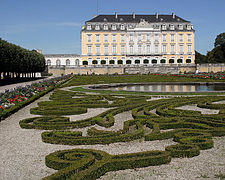
Augustusburg Castle

Falkenlust hunting lodge

Cologne cathedral

Zollverein colliery
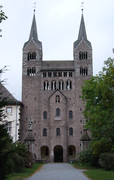
Westwork of Corvey Abbey
More top sights
- landscape
- Drachenfels with Drachenburg Castle in the Siebengebirge - At 321 meters, the Drachenfels is the most climbed mountain in the world. The Drachenfelsbahn, the oldest active rack railway in Germany, has been in operation since 1883.
- Historical buildings
- Moated castles in the Münsterland - The Münsterland is known as a “land of 100 castles”, Vischering Castle is one of them Ludinghausen corresponds, for example, to the ideal of a medieval castle; the lock North churches on the other hand bears the nickname "Westphalian Versailles"; The moated castle of Burg Anholt as one of the largest and most beautiful of these complexes is definitely part of this series.
- Hermann Monument in Detmold - larger than life statue of the Cheruscan prince who defeated the Romans in the battle of the Teutoburg Forest, created during the period of romantic nationalism.
- Mining and industrial culture
- German Mining Museum in Bochum - It is one of the most important mining museums in the world.
- Dortmund harbor: Today, building materials, coal, mineral oils, etc. are mainly handled in Europe's largest canal port.
- gasometer in Oberhausen - The gasometer was built in 1929 as a disk gasometer and, with a storage volume of 350,000 cubic meters, was the largest gas container in Europe and the second largest in the world. It is an industrial monument and symbol of the city of Oberhausen. The interior is now used for changing exhibitions, and you can also climb the gasometer to enjoy the view.
- Parks
- ZOOM Erlebniswelt Gelsenkirchen - redesigned former Ruhr Zoo. Visitor and child-friendly designed adventure zoo. The four subject areas are: Alaska (between icebergs and coastal rainforest, Africa (Magic of vastness and wilderness), Asia (the "Green Hell" of Asia) and the petting zoo Grimberger Hof.
- Means of transport
- Cologne cable car - The Rheinseilbahn is the only permanent cableway in Germany that crosses a river. It connects the two banks of the Rhine at the level of the Zoobrücke, from the zoo to the Rheinpark.
- Wuppertal suspension railway - One of the oldest overhead monorails
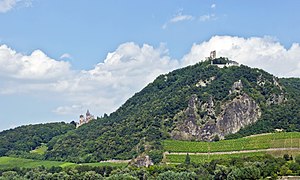
Drachenfels

Vischering Castle

Hermann Monument
.jpg/260px-Deutsches_Bergbau-Museum_Bochum_(2008).jpg)
German Mining Museum
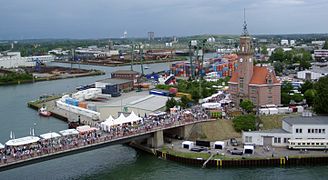
Harbor festival in the Dortmund harbor
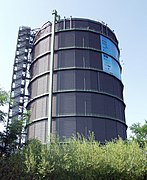
Oberhausen gasometer

Bear and arctic fox in the ZOOM

Cologne cable car
activities
To go biking
In total there are over 7,000 km of marked long-distance cycle routes in North Rhine-Westphalia.
An overview of long-distance cycle routes and regional routes is in the article Cycle routes in North Rhine-Westphalia to find.
hike
In the low mountain ranges there is a very large selection of hiking trails, not least thanks to the great commitment of the hiking clubs. One of the most famous is probably the Rothaarsteigwhich opened in 2001. It leads over 154 km over the ridge of the Rothaargebirge.
Winter sports
The Rothaar Mountains is one of the northernmost winter sports areas in the western part of Germany, which is why many North Germans and Dutch people come here for whom the route to the Alps is too far. The number 1 winter sports resort in North Rhine-Westphalia Winterberg. There are a few other winter sports areas in the Rothaargebirge. An overview is in the article Winter sports in the Sauerland and Rothaar Mountains to find.
If the weather doesn't cooperate, there are two ski halls in the state:
- Ski hall Neuss. The largest indoor ski slope in Germany with the highest artificial climbing facility in Europe.
- Alpincenter Bottrop. Downhill length: 640 m with a width of 30 m.
Culture
Several of the largest and best-known are located in North Rhine-Westphalia musical-Theater in Germany: that Starlight Express Theater in Bochum, the Capitol Theater in Dusseldorf, the Colosseum theater in eat, the Musical dome in Cologne and the Metronome theater in Oberhausen.
"Lighthouses" of the High culture in NRW are the theater Aachen, Theatre Bielefeld, Schauspielhaus Bochum, theater Bonn, the State Theater Detmold, the theater Dortmund, the Düsseldorfer Schauspielhaus, the Aalto-Theater in Essen, the music theater Gelsenkirchen, the State House and the Cologne Theater, the Oberhausen Theater, the Opera House Wuppertal as well as the German Opera on the Rhine with venues in Düsseldorf and Duisburg. The Ruhr Festival in Recklinghausen (every year in May and June) are among the largest and most renowned theater festivals in Europe and the Ruhrtriennale is a cross-art festival of international standing.
City tours
- Astrological city tour in Cologne:. The association “new learning” offers guided tours around the topic of astrology and its connection with architecture.
- Cologne smell tour:. The participants of the tour should rely entirely on their sense of smell and thus experience the stories of old Cologne in a different way.
- Love stories in Cologne:. A city tour for those who are interested in real and fictional love stories in Cologne. For example for Casanova's adventures.
- Witcher, executioner, executioner's meal in Arnsberg:. The city tour of the Arnsberg Tourist Office provides unbelievable and horrific facts about medieval law, Feme, shame penalties, etc.
- Historical city revue in Bonn:. Actors re-enact parts of Bonn's history at original locations.
- Ludwig van Beethoven guided tour in Bonn:. On the guided tour of the city “Ludwig, the music fox”, the young Beethoven personally guides the participants through Bonn and tells about his youth.
- Architecture and art tours in Cologne:. City tour to the art city of Cologne.
- 378 meters - mountain experiences. Under the name "Bergische Erlebnisse" offers 378 meters of guided tours and tours as well as events where you can experience the Bergische culture anew.
language
Standard German is also the standard language in North Rhine-Westphalia. The important Benrath line goes through the state: north of this line people say or said maken, south of it do. This important dialect boundary is considered to be the boundary between Low German and the rest of German. It is named after a place that is now part of Düsseldorf. The line crosses the Rhine at Benrath.
Even if some people use Low German (Low German), the people in North Rhine-Westphalia all speak High German or a dialect of High German. This also applies to the so-called Ruhr German, which is used to summarize most of the dialects in the Ruhr area. Popular cabaret artists and actors of this dialect were or are Jürgen von Manger (as Adolf Tegtmeier), Tana Schanzara, Uwe Lyko (as Herbert Knebel) and the Missfits.
The west of the country knows many dialect differences: It belongs to the Rhenish Fan, where the transition from Middle German to Low German has several important dialect borders. The Lower Rhine belongs to the Lower Franconian and is very similar to the Low German. A well-known cabaret artist from Niederhein was Hanns-Dieter Hüsch.
One of the most famous city dialects in Germany is probably that of Cologne and the surrounding area. It belongs to Middle Franconian and sounds a lot more like the Middle German dialects, although a lot of Low German can also be recognized (for example by “dat” and “wat”). Kölsch is known for the carnival, the Millowitsch theater, cabaret artists like Jürgen Becker and music groups like the Bläck Fööss.
to buy
kitchen
Information about the kitchen can also be found on the pages Eating and drinking in the Rhineland and Eating and drinking in Westphalia
nightlife
accommodation
Learn
There are universities and colleges in the following cities:
Aachen, Alfter, Bad Honnef, Bad Münstereifel, Bielefeld, Bochum, Bonn, Brühl, Detmold (music), Dortmund, Düsseldorf, Duisburg, Essen, Gelsenkirchen, Hagen (Fern University), Hamm, Herford, Iserlohn, Kleve, Cologne, Krefeld, Lemgo, Minden, Mülheim an der Ruhr, Münster, Neuss, Nordkirchen, Paderborn, Rheine, Siegen, St. Augustin, Unna, Witten / Herdecke and Wuppertal
Work
public holidays
| Next appointment | Surname | importance |
|---|---|---|
| Saturday 1st January 2022 | New Year | New Years Day |
| Friday April 15, 2022 | Good Friday | highest Christian holiday, commemoration of the crucifixion of Christ |
| Sunday April 17th 2022 | Easter Sunday | Easter, commemoration of the resurrection of Christ |
| Monday April 18, 2022 | Easter Monday | Easter, commemoration of the resurrection of Christ |
| Saturday 1st May 2021 | May Day | International Labor Day |
| Thursday May 13th 2021 | Ascension of Christ | 40 days after Easter, commemoration of the Ascension of Christ |
| Sunday 23 May 2021 | Pentecost Sunday | 7 weeks after Easter, commemoration of the pouring out of the Holy Spirit |
| Monday, May 24, 2021 | Whit Monday | 1 day after Pentecost Sunday, commemoration of the pouring out of the Holy Spirit |
| Thursday 3rd June 2021 | Corpus Christi | Catholic solemnity of the bodily presence of Christ in the Eucharist |
| Sunday 3rd October 2021 | Day of German unity | National holiday |
| Monday 1st November 2021 | All Saints Day | Christian festival at which all saints are remembered |
| Saturday 25 December 2021 | 1st Christmas Day | Christmas, commemoration of the birth of Christ |
| Sunday 26 December 2021 | 2nd Christmas Day | Christmas, commemoration of the birth of Christ |
Christmas Eve (December 24th) and New Year's Eve (December 31st) are not public holidays. Nevertheless, many businesses are closed all day and many shops and leisure facilities are closed from midday on these days. Depending on the city, local public transport can be severely restricted or even stopped from the afternoon onwards. Most of the restaurants are also closed on Christmas Eve.
School holidays
| vacation | 2020 | 2021 | 2022 | 2023 | 2024 |
|---|---|---|---|---|---|
| Easter | 06.04.-18.04. | 29.03.-10.04. | 11.04.-23.04. | 03.-15.04. | 25.03.-06.04. |
| Pentecost | 02.06. | 25.05. | -- | 30.05. | 21.05. |
| summer | 29.06.-11.08. | 05.07.-17.08. | 27.06.-09.08. | 22.06.-04.08. | 08.07.-20.08. |
| autumn | 12.10.-24.10. | 11.10.-23.10. | 04.10.-15.10. | 02.10.-14.10. | |
| Christmas | 23.12.-06.01. | 24.12.-08.01. | 23.12.-06.01. | 21.12.-05.01. |
Furthermore, there are three to four flexible vacation days in NRW, which are determined locally. These are often the so-called bridging days between public holidays and weekends.
The long-term summer vacation dates can be found at the Conference of Ministers of Education can be read.
security
The safest cities in Germany are in North Rhine-Westphalia: Twelve of the 20 large cities with over 200,000 inhabitants with the lowest crime rate are in the most populous federal state. According to statistics from the Federal Criminal Police Office for 2006 Wuppertal the safest city in Germany, followed by Bielefeld in second place Mönchengladbach (4th place), eat (5), Gelsenkirchen (6) and Aachen (10) are four other cities in North Rhine-Westphalia among the top ten. Follow in the nationwide list of cities with more than 200,000 inhabitants Duisburg (12), Muenster (15), Krefeld (16), Oberhausen (18), Bonn (19) and Dortmund (20). The other side of the coin: the state capital Dusseldorf has to struggle with the second highest crime rate in Germany, only Frankfurt am Main is an even more unsafe place.
health
climate
respect
Occasionally there are subliminal negative oscillations between Rhineland and Westphalia, or Westphalia and Lippern. Travelers shouldn't poke around in the wound if they don't want to hear hours of lectures about disadvantages vis-à-vis the other region.
literature
Web links
- https://www.land.nrw/ - Official website of North Rhine-Westphalia
- official website of NRW Tourismus e.V.
- Current weather radar for the state of North Rhine-Westphalia



.jpg/330px-Stadtbild_Köln_(50MP).jpg)






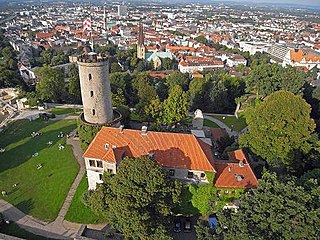













.jpg/350px-Flughafen_Köln-Bonn_-_Terminal_1_Hauptgebäude_(9054-56).jpg)













.jpg/260px-Deutsches_Bergbau-Museum_Bochum_(2008).jpg)




